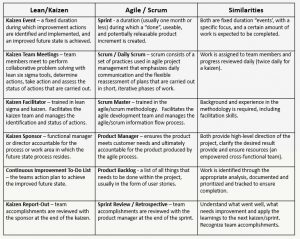
Our previous article covered the benefits of comparing the DMAIC problem solving thought process with project management. The key takeaway was DMAIC can be more effectively executed using “measure & plan” phase.
Now let’s compare and contrast agile/scrum with lean/kaizen. While agile is primarily used in software development, there are many valid comparisons. By making this comparison, those familiar with kaizen will improve their understanding of agile and vice-versa. Also we’ll cover key success factors that are applicable to both.
First, let’s define lean and agile…lean manufactures physical goods while agile develops digital products. Lean is producing what is needed, when it is needed, in exactly the right quantities, with perfect quality, in the least amount of time and with the least amount of resources. Agile is an iterative development methodology (usually for software), where requirements and solutions evolve through collaboration between cross-functional teams. Both are, or should be, in place on a continuous basis (for organizations that decide to pursue these structured approaches).
Meanwhile, scrum is a process by which agile is executed. While scrum is primarily used in software development, there are many valid comparisons between kaizen and scrum as shown in the following table:
Since the purpose of the article is to focus on similarities, we’ll cover differences between agile/scrum and lean/kaizen in other articles. Meanwhile, some fundamentals apparent in the comparison are as follows. Both involve:
- a structured approach
- project and team-member sponsorship
- empowered team members
- a process expert & facilitator
- visual controls
- visibility of team outcomes and effectiveness
- feedback loop (via report-out or retrospective)
- recognition of team accomplishments
Hopefully this article provides an improved understanding of the specific approaches, as well as key success factors for virtually any team-based or cross-functional company initiative.

This post presents a valuable comparison between two prominent methodologies – Lean/Kaizen and Agile/Scrum, highlighting the benefits of understanding and contrasting these approaches.